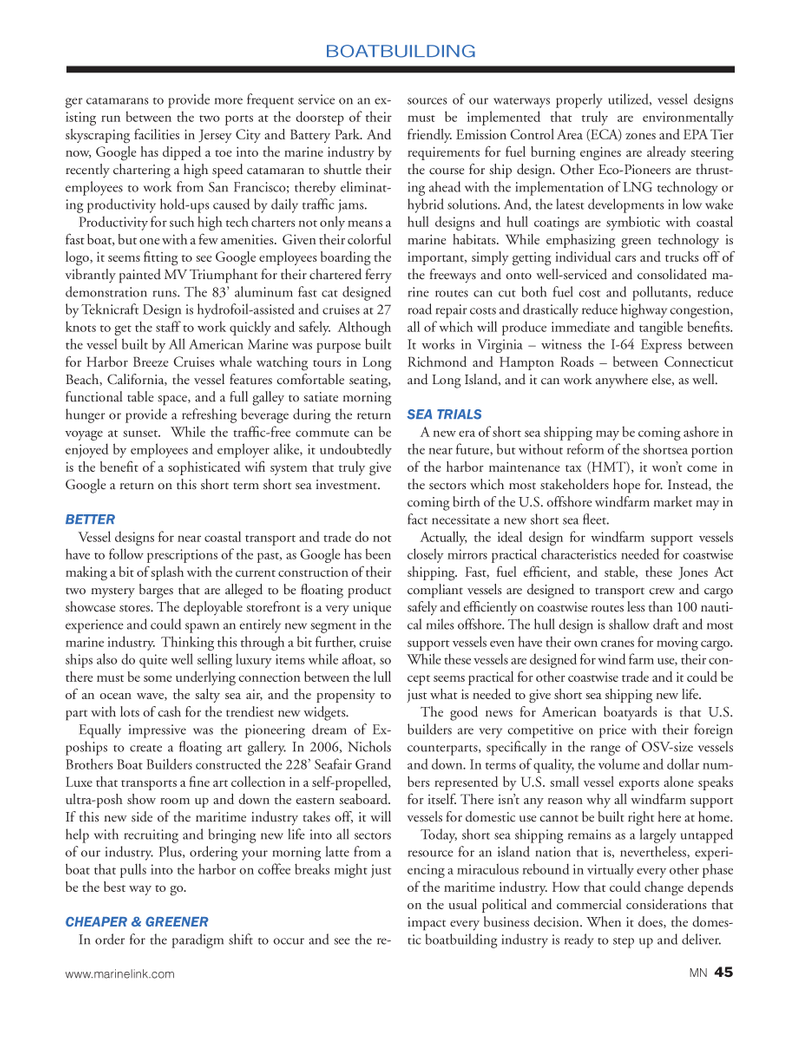
Page 45: of Marine News Magazine (March 2014)
Fleet & Vessel Optimization
Read this page in Pdf, Flash or Html5 edition of March 2014 Marine News Magazine
BOATBUILDING ger catamarans to provide more frequent service on an ex- isting run between the two ports at the doorstep of their skyscraping facilities in Jersey City and Battery Park. And now, Google has dipped a toe into the marine industry by recently chartering a high speed catamaran to shuttle their employees to work from San Francisco; thereby eliminat- ing productivity hold-ups caused by daily traffi c jams.
Productivity for such high tech charters not only means a fast boat, but one with a few amenities. Given their colorful logo, it seems fi tting to see Google employees boarding the vibrantly painted MV Triumphant for their chartered ferry demonstration runs. The 83’ aluminum fast cat designed by Teknicraft Design is hydrofoil-assisted and cruises at 27 knots to get the staff to work quickly and safely. Although the vessel built by All American Marine was purpose built for Harbor Breeze Cruises whale watching tours in Long
Beach, California, the vessel features comfortable seating, functional table space, and a full galley to satiate morning hunger or provide a refreshing beverage during the return voyage at sunset. While the traffi c-free commute can be enjoyed by employees and employer alike, it undoubtedly is the benefi t of a sophisticated wifi system that truly give
Google a return on this short term short sea investment.
BETTER
Vessel designs for near coastal transport and trade do not have to follow prescriptions of the past, as Google has been making a bit of splash with the current construction of their two mystery barges that are alleged to be fl oating product showcase stores. The deployable storefront is a very unique experience and could spawn an entirely new segment in the marine industry. Thinking this through a bit further, cruise ships also do quite well selling luxury items while afl oat, so there must be some underlying connection between the lull of an ocean wave, the salty sea air, and the propensity to part with lots of cash for the trendiest new widgets.
Equally impressive was the pioneering dream of Ex- poships to create a fl oating art gallery. In 2006, Nichols
Brothers Boat Builders constructed the 228’ Seafair Grand
Luxe that transports a fi ne art collection in a self-propelled, ultra-posh show room up and down the eastern seaboard.
If this new side of the maritime industry takes off, it will help with recruiting and bringing new life into all sectors of our industry. Plus, ordering your morning latte from a boat that pulls into the harbor on coffee breaks might just be the best way to go.
CHEAPER & GREENER
In order for the paradigm shift to occur and see the re- sources of our waterways properly utilized, vessel designs must be implemented that truly are environmentally friendly. Emission Control Area (ECA) zones and EPA Tier requirements for fuel burning engines are already steering the course for ship design. Other Eco-Pioneers are thrust- ing ahead with the implementation of LNG technology or hybrid solutions. And, the latest developments in low wake hull designs and hull coatings are symbiotic with coastal marine habitats. While emphasizing green technology is important, simply getting individual cars and trucks off of the freeways and onto well-serviced and consolidated ma- rine routes can cut both fuel cost and pollutants, reduce road repair costs and drastically reduce highway congestion, all of which will produce immediate and tangible benefi ts.
It works in Virginia – witness the I-64 Express between
Richmond and Hampton Roads – between Connecticut and Long Island, and it can work anywhere else, as well.
SEA TRIALS
A new era of short sea shipping may be coming ashore in the near future, but without reform of the shortsea portion of the harbor maintenance tax (HMT), it won’t come in the sectors which most stakeholders hope for. Instead, the coming birth of the U.S. offshore windfarm market may in fact necessitate a new short sea fl eet.
Actually, the ideal design for windfarm support vessels closely mirrors practical characteristics needed for coastwise shipping. Fast, fuel effi cient, and stable, these Jones Act compliant vessels are designed to transport crew and cargo safely and effi ciently on coastwise routes less than 100 nauti- cal miles offshore. The hull design is shallow draft and most support vessels even have their own cranes for moving cargo.
While these vessels are designed for wind farm use, their con- cept seems practical for other coastwise trade and it could be just what is needed to give short sea shipping new life.
The good news for American boatyards is that U.S. builders are very competitive on price with their foreign counterparts, specifi cally in the range of OSV-size vessels and down. In terms of quality, the volume and dollar num- bers represented by U.S. small vessel exports alone speaks for itself. There isn’t any reason why all windfarm support vessels for domestic use cannot be built right here at home.
Today, short sea shipping remains as a largely untapped resource for an island nation that is, nevertheless, experi- encing a miraculous rebound in virtually every other phase of the maritime industry. How that could change depends on the usual political and commercial considerations that impact every business decision. When it does, the domes- tic boatbuilding industry is ready to step up and deliver. www.marinelink.com MN 45
MN MAR14 Layout 32-49.indd 45 2/21/2014 3:29:14 PM

 44
44

 46
46
